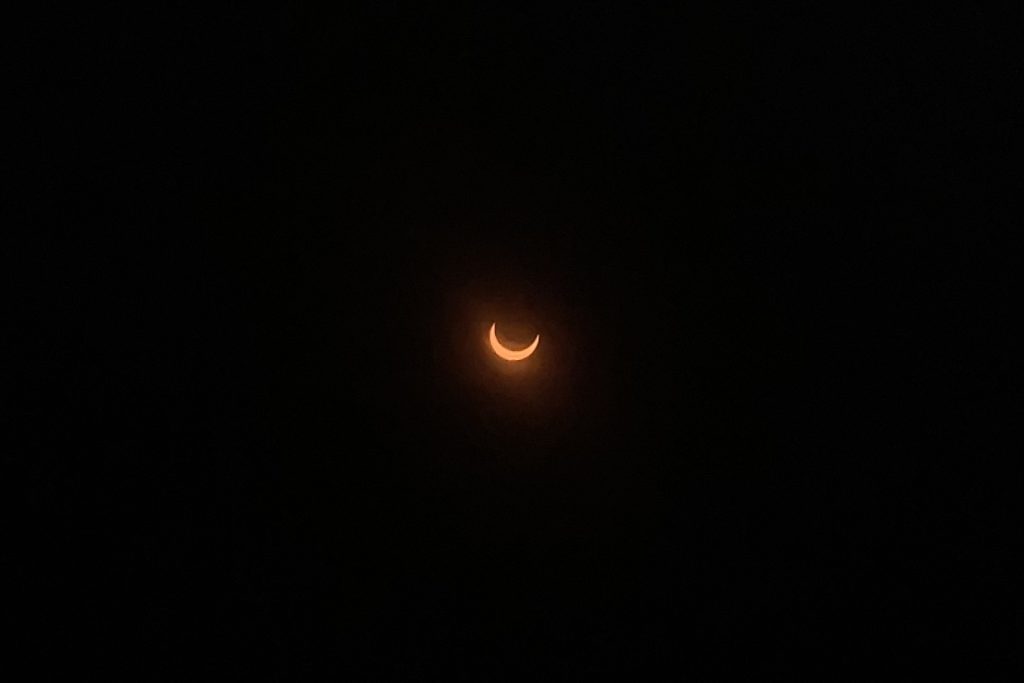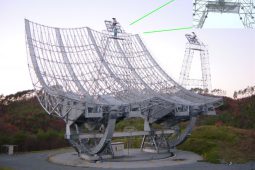DPS-EPSC学会(テキサス州)にて研究発表を行いました (2023/10/1–5)

現地時間2023年10月1日から6日まで、アメリカ・テキサス州サンアントニオにてDPS-EPSC学会(The Division for Planetary Sciences Joint with EPSC)が開催され、佐藤晋之祐(修士2年)が口頭発表を、土屋史紀教授がポスター発表をそれぞれ行いました。この記事ではDPS-EPSCの様子をまとめます (文責: 佐藤晋之祐)
DPS-EPSCは、太陽系内外の惑星や小天体を研究する世界中の研究者が集まる国際学会です。55回目となる本講演会は、テキサス州・サンアントニオにて開催されました。

海外学会で初めての口頭発表に臨みました (撮影: 土屋史紀)
晋之祐にとってはMOP2022以来の海外学会で、かつ海外学会では初めての口頭発表に臨みました。緊張はしましたが、事前に練習を重ねたおかげで良い発表ができたと思います。学会期間中には、主に木星探査機Junoチームの研究者と個別にミーティングを設定し、研究の議論を進めました。対面でのミーティングはオンラインに比べて共有できる情報量が圧倒的に多く、約20時間(乗継含む)をかけてテキサスまで来て良かった!と心の底から思いました。
1枚目の画像は、サンアントニオの観光名所であるRiver Walkの夜景です。アメリカ中南部の乾燥したイメージとは異なり、サンアントニオはRiverwalkを中心とした水の都でした。Riverwalkに沿ってたくさんのレストランが営業を行なっており、夕刻には綺麗なライトアップを眺めながら屋外ダイニングを楽しむこともできました。テキサス州はメキシコに近いため、タコスを始めとするメキシカン料理のお店が多い印象です。私は、コロナリータというお酒を初めて飲みとても気に入りました。有名なメキシコビールの「コロナ」と、テキーラで作る「マルガリータ」を混ぜたお酒です。日本ではなかなかお目にかかれない組み合わせでしたが、癖になる美味しさでした。

元PPARC教員の諸岡さん(現ウプサラ大学)ともお会いしました。River Walk沿いのシュリンプ料理のお店にて。
晋之祐はDPS終了後も、Junoサイエンスチームミーティングに出席するためにサンアントニオに滞在し続けました。14泊のテキサス出張は、楽しいことも疲れることもたくさんあり、帰りのフライトではぐっすり眠り…たかったのですが、乱気流に何度も遭遇し一睡もできませんでした(涙)。機内頭上のラゲージの蓋が何度も開いてしまうほど揺れていました。無事に帰って来れて良かったです。
帰国便は現地時間の10月14日のフライトでした。実は、アメリカ中部ではその日に金環日食が見れるとのことで、事前に日食グラスを用意し、かつ帰りのフライトは窓側を指定し、徹底した(笑)準備のもと帰路につきました。フライトの遅れなどもあり、機内から日食の観測に成功しました!食の最大まで見守ることはできませんでしたが、自身2012年以来となる日食観測ができて良かったです。

帰国フライトの機内から観測した日食。
今回の出張で、たくさんの経験を積むことができました。しばらくは、修士論文の執筆と審査会の準備に追われる日々が続きます。(完)
DPSにて行った研究発表のタイトルとアブストラクトは以下の通りです。
Title: Interpretation of the North-South Asymmetric Oxygen Aurora Morphology on Europa Using Test Particle Simulation
Europa has a tenuous atmosphere composed mostly of molecular oxygen. Observations using the Hubble Space Telescope (HST) reported that the oxygen OI] 135.6 nm auroral emissions in Europa’s atmosphere has a north-south asymmetric brightness morphology which changes with the position of Europa with respect to the Jovian magnetospheric plasma sheet (Roth et al., 2016). Similar north-south asymmetry of Io’s auroral limb glow has been observed and explained by higher electron flux into the atmosphere on the hemisphere that faces the plasma sheet center (Retherford et al., 2003). This explanation, however, has not yet been evaluated for the case of Europa quantitatively.
In this study, we conducted a test particle simulation for the Jovian magnetospheric electrons to estimate the brightness of the 135.6 nm oxygen aurora in Europa’s atmosphere and to investigate the cause of the north-south asymmetry using the previously suggested idea, in which the strong deceleration of the magnetospheric plasma flux tube results in the inhomogeneous electron precipitation into the atmosphere (the “slow-down effect”). We successfully reproduced the systematic change of the north-south asymmetry of Europa’s oxygen aurora at 135.6 nm with the “slow-down effect” scenario. The maximum north-to-south brightness ratio is estimated at 2.56 on the leading (plasma-downstream) side and at 2.17 on the trailing (upstream) side with the “slow-down effect” of deceleration to 10% of the background plasma bulk flow. However, the observed brightness ratio is actually larger on the trailing side (Roth et al., 2016). Besides, the “slow-down effect” model requires a strong deceleration of the entire flux tube at Europa’s location to recreate the observed north-to-south brightness ratio, while our calculation suggests that the 40% slowdown, derived from the Galileo/PLS data at its E12 flyby in Huybrighs (2019), is not sufficient. Harris et al. (2021) conducted the MHD simulations to show that the spatial scale of the flux tube deceleration is limited near Europa. Our conclusion therefore is that the “slow-down effect” does not fully explain the north-south asymmetry of Europa’s oxygen aurora and that additional investigations with both observational and modeling approaches are required to understand the generation of Europa’s asymmetric aurora morphology.
Title: LAPYUTA (Life-environmentology, Astronomy, and PlanetarY Ultraviolet Telescope Assembly) mission
The LAPYUTA (Life-environmentology, Astronomy, and PlanetarY Ultraviolet Telescope Assembly) is an ultraviolet space telescope mission scheduled for launch in the early 2030s. In April 2023, the LAPYUTA mission was selected as a candidate for the 6th JAXA M-class mission. LAPYUTA has following four objectives. Objective 1 will focus on the boundary region between space and planets/moons in the solar system. We will perform continuous monitoring of water plumes erupted on the surface of Jupiter’s icy moons and auroral emissions on the icy moons and the planet to elucidate the material and energy supply processes in the moons. The global distributions of water and greenhouse gases in the upper atmosphere of Mars and Venus enables us to uncover how these gases diffuse into space through the coupling between the lower and upper atmospheres and responses from the solar wind and solar activity. Objective 2 is to detect the atmospheres of exoplanets in the habitable zone and to estimate the surface environment of the planets by characterizing their atmospheres. For cosmology and astronomy, Objective 3 is to test whether the structures of present-day galaxies contain ubiquitous Lyα halos and to reveal the physical origins of Lyα halos, and Objective 4 elucidates the heavy element synthesis process from observations of ultraviolet radiation from hot gas immediately after neutron star mergers. To achieve these science objectives, LAPYUTA will perform spectroscopic and imaging observation in the far ultraviolet spectral range (110-190 nm) by a space telescope with a large effective area (>300 cm2) and high spatial resolution (0.1 arcsec). The main scientific payload is a Cassegrain-type telescope with a 60 cm diameter primary mirror. Two main UV instruments are installed in the focal plane of the telescope: a spectrograph and a slit imager. The spectrograph will have a spectral resolution of 0.02 nm and a field of view of >70 arcsec. The UV slit imager will consist of imaging optics, multiple bandpass filters with a rotating wheel, and a UV detector. To achieve a high spatial resolution of 0.1 arcsec, a target monitoring camera is installed at the slit imager and the 0th order position inside the spectrometer for attitude control and image correction.





